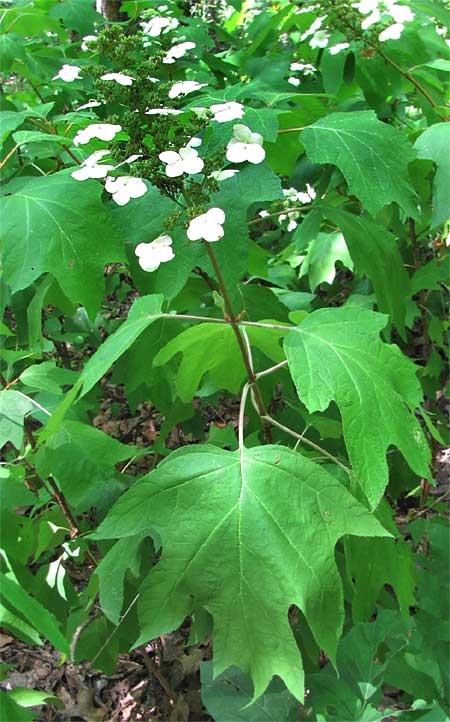Excerpts from Jim Conrad's
Naturalist Newsletter

from the July 13, 2008 Newsletter, written in central Mississippi:
OAKLEAF HYDRANGEAS FLOWERING
At our first campground at Rocky Springs about 55 miles north of Natchez I'd been disappointed that the flowering Oakleaf Hydrangeas were past their prime, their spectacular pink or pinkish white flowers already faded. However, at Jeff Busby campground about 200 miles north of Natchez, thus phenologically closer to spring, flowers were still at their prime, as shown below:

Oakleaf Hydrangeas, HYDRANGEA QUERCIFOLIA, distributed mostly in the US Deep South, are easily distinguishable from the species known as Wild Hydrangea, H. arborescens, common in rich woods throughout most of the forested eastern US. First, flowers of Wild Hydrangeas are distributed in flat- to round-toped inflorescences called corymbs, while you can see that blossoms of Oakleaf Hydrangeas are arranged in elongate clusters called panicles. Second, Wild Hydrangea leaves are unlobed, while Oakleaf Hydrangea's coarse, woolly-bottomed leaves are deeply incised, and lobed almost like Sugar Maple leaves.
In the hydrangea's flower cluster, the conspicuous items in the picture looking like large, white flowers with four petals are actually sterile, modified flowers consisting of nothing but calyx lobes. They serve the plant as if they were flowers, attracting pollinators to the inflorescence's much smaller, less conspicuous flowers. I took a picture of an inflorescence from directly above it, showing the sterile, modified calyxes on the outside and the densely packed actual flowers on the inside, and it's at the top of this page.
The inflated calyx lobes of some Oakleaf Hydrangeas are bright pink, while those in the picture are almost pure white. Whatever the color, the plant is very handsome. It does grace gardens here and there but it deserves far wider recognition as a valuable ornamental. Sometimes when it's planted farther north it escapes from cultivation, but seldom persists or reproduces for long.